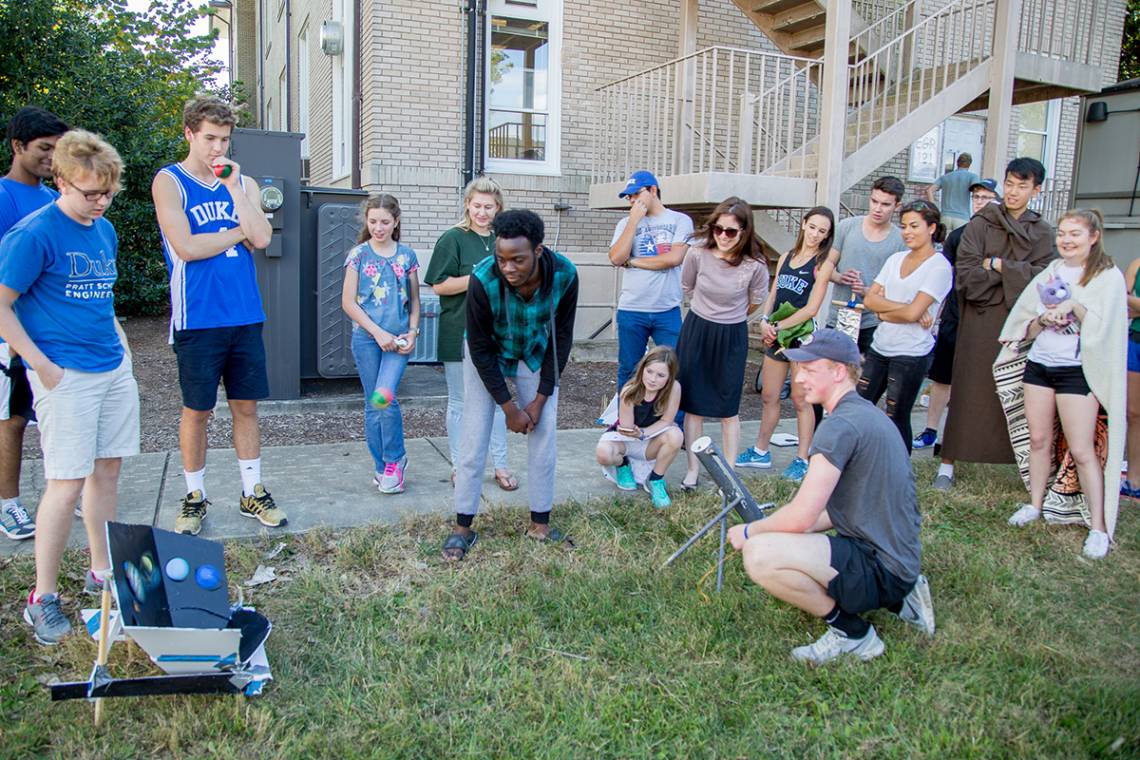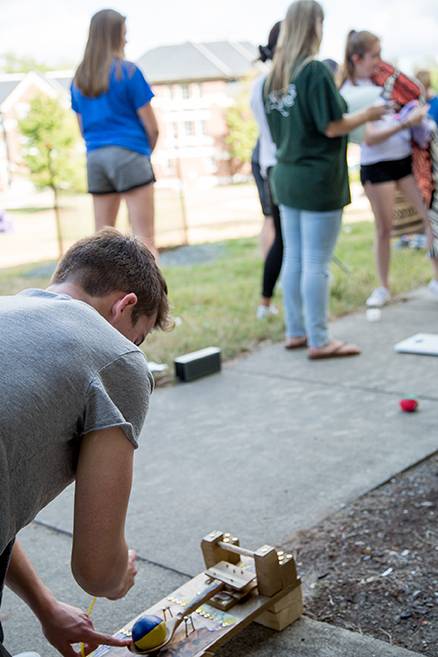Students Connect Engineering and Entrepreneurship in Technology & Design Pathway

Engineering Innovation (EGR121L)
Students in Becky Simmons’ Engineering Innovation class assembled devices made of springs, wooden spoons, bits of string, tubes and other various materials on a sunny day on the East Campus quad. The challenge, called “fall fling,” had one objective: to launch a juggling ball from one device and catch it in a spray paint cap inside another device.
The stakes were high – the students’ grades depended on the number of catches in a specified time period, as well as the distance the ball traveled – but the students still had some fun with the assignment, making their devices match a theme. One looked like a Hubble telescope, while another was a mini replica of the court in Cameron Indoor Stadium.
Anuj Thakkar, a sophomore who is pursuing the I&E Certificate, was one of the team members adjusting the mini basketball court. As a mechanical engineering major at the Pratt School of Engineering, he was required to take Engineering Innovation, or EGR121L. The class can also count toward the I&E Certificate’s Technology & Design Pathway.
 Thakkar said he chose to pursue the I&E Certificate because he’s been interested in startups for some time and wanted to be surrounded by likeminded people.
Thakkar said he chose to pursue the I&E Certificate because he’s been interested in startups for some time and wanted to be surrounded by likeminded people.
The two-week project required students to learn how to design within constraints. A previous challenge focused on reverse engineering, and groups were tasked with taking apart household appliances and determining how to make them more cost effective.
Throughout the semester, the students also go through the following challenges: designing a Happy Meal toy using SOLIDWORKS and 3D printing; identifying, defining, and solving a true problem on campus; and designing a Rube Goldberg machine that will allow a ball to travel in a complex series of paths from group to group, initiating an electronic sensor at each group’s stop.
“It’s a great early opportunity for the students to do design innovation prototyping,” Simmons said.
Technology Commercialization (I&E 281)
Students taking Technology Commercialization get the feeling of a business school class without ever stepping foot into a business school.
Co-taught by Salman Azhar, a faculty member in the Fuqua School of Business, and Rob Hallford, Associate Director, New Ventures in Duke’s Office of Licensing & Ventures, the course teaches students the necessary steps to turn a technology into a product.
Hallford teaches the first half of the course, focusing on medical devices, biotechnology and intellectual property. Azhar takes over the second half of the semester, teaching about starting and scaling a new venture in technology, including funding, traction, pivoting and risk management.
 For their final presentations, groups of students must choose a technology and create a realistic plan to commercialize it, applying class principles as they think through questions like “What kind of applications can be created around the technology?” and “How can we bring this technology to market?”
For their final presentations, groups of students must choose a technology and create a realistic plan to commercialize it, applying class principles as they think through questions like “What kind of applications can be created around the technology?” and “How can we bring this technology to market?”
Students choose from technologies that haven’t yet been commercialized, such as self-driving cars or various medical technologies.
Although the course involves lectures, Azhar said the course is more discussion-based and that he sees his role as a moderator to get the best ideas out of the students.
Hallford added that the course is taught like a business school class, using real technologies as case studies.
“The course stretches students into the realm of ambiguities that exist in real life,” Hallford said. “It teaches them to deal with questions that arise and allows them to realize there’s not always a right answer.”